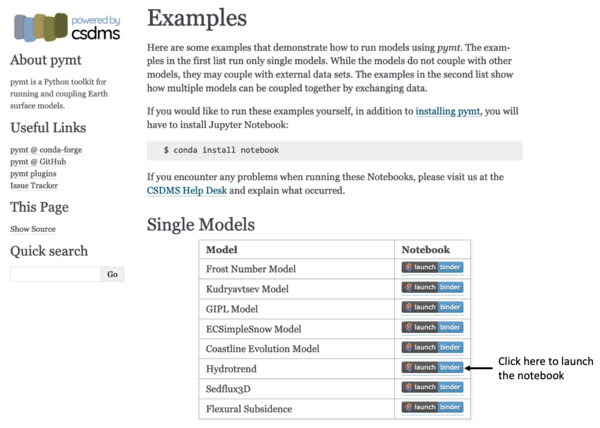Lab-0005: Difference between revisions
m (Update download and run online URLs) |
m (Minor edits to text) |
||
| Line 16: | Line 16: | ||
}} | }} | ||
{{LabIntro | {{LabIntro | ||
|LabDescription= | |LabDescription=In this lab, we use the HydroTrend model to investigate river sediment supply to the ocean by exploring the effects of climate change on river fluxes. We also look at the effect of humans on rivers: the building of a reservoir. | ||
The HydroTrend model is run with the Python Modeling Tool, ''pymt''. Learn more about ''pymt'' at: https://pymt.readthedocs.io. | |||
<br> | |||
For additional information, see also the spreadsheet lab: https://csdms.colorado.edu/mediawiki/images/RiverFluxtoOceanSpreadsheetLab.zip | |||
|LabPicture=Lab3sedsupply.png | |LabPicture=Lab3sedsupply.png | ||
}} | }} | ||
{{LabClassroomOrganization | {{LabClassroomOrganization | ||
|LabCOIntro=In this lab, we are using a theoretical river basin of ~1990 km<sup>2</sup>, with 1200m of relief and a river length of ~100 km. All parameters that are shown by default once the HydroTrend | |LabCOIntro=In this lab, we are using a theoretical river basin of ~1990 km<sup>2</sup>, with 1200m of relief and a river length of ~100 km. All parameters that are shown by default once the HydroTrend model is loaded are based on a present-day, temperate climate. | ||
Whereas these runs are not meant to be specific, we are using parameters that are realistic for the Waiapaoa River in New Zealand. The Waiapaoa River | Whereas these runs are not meant to be specific, we are using parameters that are realistic for the Waiapaoa River in New Zealand. The Waiapaoa River, located on North Island, receives high rain and has erodible soils, so the river sediment loads are exceptionally high. It has been called the 'dirtiest small river in the world'. A more detailed description of applying HydroTrend to the Waipaoa basin has been published in ''Water Resources Research'': http://dx.doi.org/10.1029/2006WR005570. To learn more about HydroTrend and its approach to sediment supply modeling, download the presentation listed below. | ||
This lab | This lab can be run on the CSDMS JupyterHub. (If you don't already have an account, follow the instructions to sign up at: https://csdms.colorado.edu/wiki/JupyterHub.) Run the lab Notebook by clicking the "start" link under the Run online heading at the top of this page. If you're teaching at an academic institution, you can get CSDMS JupyterHub accounts for students in your class. For more information, please contact us the CSDMS Help Desk: https://github.com/csdms/help-desk. | ||
|LabCOPresentationUpload=SedimentSupplyModeling02_2013.ppt | |LabCOPresentationUpload=SedimentSupplyModeling02_2013.ppt | ||
|LabCOPresentationText= | |LabCOPresentationText=Learn more about HydroTrend and its approach to sediment supply modeling from this presentation. | ||
}} | }} | ||
{{LabLearningObjectivesSkills | {{LabLearningObjectivesSkills | ||
Revision as of 16:55, 25 August 2020
Sediment Supply to the Global Ocean
Contributor(s)
The HydroTrend model is run with the Python Modeling Tool, pymt. Learn more about pymt at: https://pymt.readthedocs.io.
Classroom organization
In this lab, we are using a theoretical river basin of ~1990 km2, with 1200m of relief and a river length of ~100 km. All parameters that are shown by default once the HydroTrend model is loaded are based on a present-day, temperate climate.
Whereas these runs are not meant to be specific, we are using parameters that are realistic for the Waiapaoa River in New Zealand. The Waiapaoa River, located on North Island, receives high rain and has erodible soils, so the river sediment loads are exceptionally high. It has been called the 'dirtiest small river in the world'. A more detailed description of applying HydroTrend to the Waipaoa basin has been published in Water Resources Research: http://dx.doi.org/10.1029/2006WR005570. To learn more about HydroTrend and its approach to sediment supply modeling, download the presentation listed below.
This lab can be run on the CSDMS JupyterHub. (If you don't already have an account, follow the instructions to sign up at: https://csdms.colorado.edu/wiki/JupyterHub.) Run the lab Notebook by clicking the "start" link under the Run online heading at the top of this page. If you're teaching at an academic institution, you can get CSDMS JupyterHub accounts for students in your class. For more information, please contact us the CSDMS Help Desk: https://github.com/csdms/help-desk.Download associated file: SedimentSupplyModeling02_2013.ppt
Learn more about HydroTrend and its approach to sediment supply modeling from this presentation.
Skills
- use Pymt to run HydroTrend Model
- familiarize with a basic configuration of the HydroTrend Model
- make small changes to key input parameters
- hands-on experience with visualizing output in Python
- explore the HydroTrend base-case river simulation
- how does a river system respond to climate change
- how do human affect river sediment loads
Lab notes
You can launch binder to directly run the Jupyter Notebook for this lab through a web browser.
>> Open a new browser window and open the Pymt read the docs page at: https://pymt.readthedocs.io/en/latest/examples.html
>> You will see that there are several example models. In this lab we will select the HydroTrend model.
>> Click on the 'Launch Binder' box and it will allow you to see this lab as a Jupyter Notebook.
>> You can execute the Jupyter notebook code cells using shift -enter.Requirements
--
References
- Kettner, A.J., and Syvitski, J.P.M., 2008. HydroTrend version 3.0: a Climate-Driven Hydrological Transport Model that Simulates Discharge and Sediment Load leaving a River System. Computers & Geosciences, 34(10), 1170-1183. doi: 10.1016/j.cageo.2008.02.008


